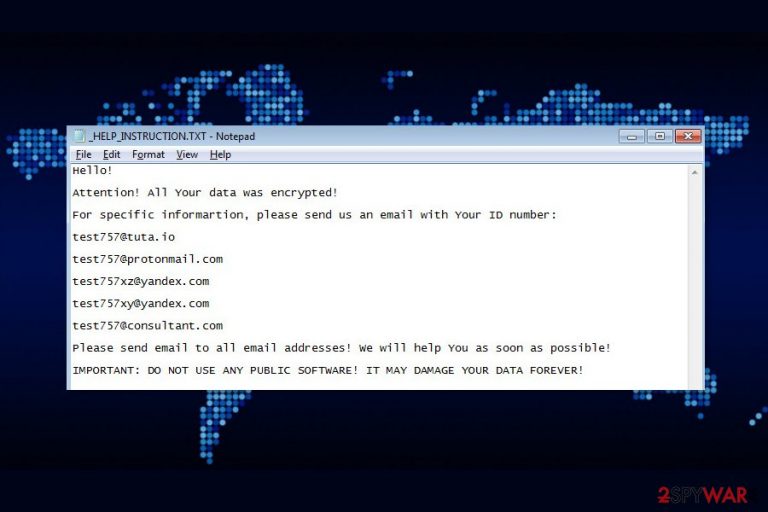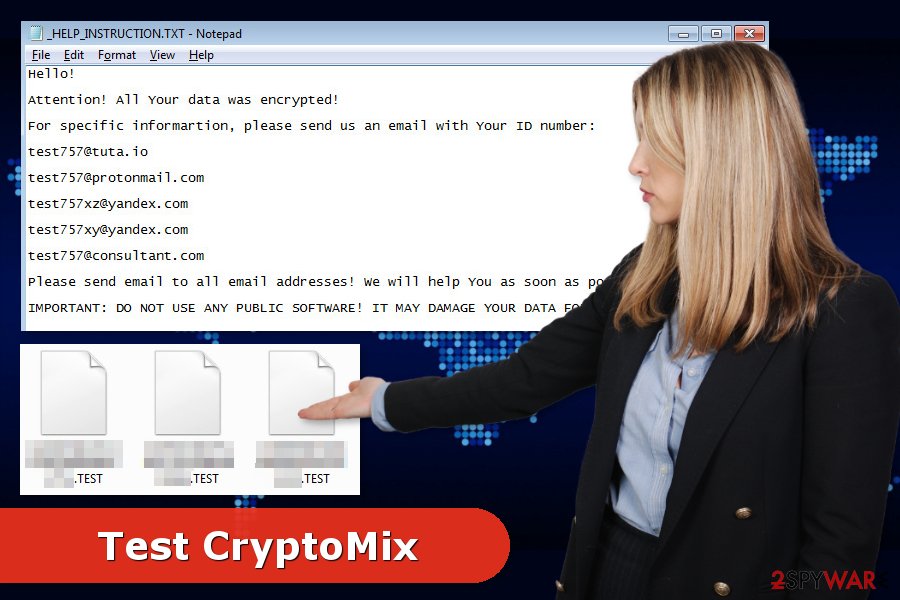Test ransomware (Virus Removal Guide) - Recovery Instructions Included
Test virus Removal Guide
What is Test ransomware?
Test ransomware – an updated variant of CryptoMix malware

Test ransomware is another variant of CryptoMix ransomware family. The virus appends .TEST file extension to the targeted image, audio, video, text, document and many other targeted files. Malware delivers a file recovery instructions in the _HELP_INSTRUCTION.TXT file.
Test CryptoMix ransomware uses a combination of 11 public RSA-1024 and AES key for data encryption. The same encryption technique was used by previous versions of malware – 0000 and XZZX viruses. In addition, malware is designed to delete Shadow Volume Copies. Thus, data recovery becomes nearly impossible.
Following the encryption procedure, Test virus delivers a ransom note in the text file. Here, crooks tell to send their unique ID number to one of the provided emails in order to get detailed data recovery instructions. Currently, developers of ransomware use these email addresses:
- test757@tuta.io,
- test757@protonmail.com,
- test757xz@yandex.com,
- test757xy@yandex.com,
- test757@consultant.com.
Cyber criminals will respond with a particular Bitcoin wallet address, and the sum of Bitcoins victims have to pay for the decryption software. However, transferring the ransom is never recommended[1] because hackers might ask for even more money and never send you decryption software.
Despite the fact that ransomware is currently undecryptable and chances to restore files with third-party software are low, you should still remove Test ransomware virus from the computer. The malicious program makes severe changes to the system that makes your PC vulnerable and unsafe to use.
Ransomware elimination should be performed with professional security software because crypto-malware might affect legitimate system processes. Thus, wiping out this cyber threat manually is nearly impossible. You should obtain FortectIntego or another anti-malware for Test ransomware removal.

Keeping away from suspicious email attachments helps to avoid ransomware attack
Test CryptoMix ransomware is most likely to infiltrate the system once you open an infected email attachment. These letters look legitimate and might inform about an important issue. Thus, unsuspecting victims can easily be convinced to open an unknown email.
Despite the fact that malicious spam email attachments remain one of the most popular ransomware distribution methods, malware researchers team from LosVirus[2] note that file-encrypting virus might be spread via:
- malware-laden ads;
- fake or illegal software downloads;
- bogus updates;
- exploit kits;
- unprotected RDP connections.
Thus, security experts recommend paying attention and do not rush to click any content.[3] Always make sure that the download source is reliable and safe. Additionally, you should keep programs and operating system updated, install security software and create backups. Saving important files in the external storage devices or cloud helps to decrease the damage in case of cyber attack.
Remove Test CryptoMix ransomware virus
In order to remove Test ransomware entirely and without causing damage to the system, you have to use malware removal software. Numerous professional tools can help you to eliminate malicious components from the system. However, if you have no idea which one to choose, take our advise and obtain FortectIntego, SpyHunter 5Combo Cleaner or Malwarebytes.
Below you will find the guide which will help to disable the virus in order to install and run a system scan with a security tool. After Test removal, you can try to restore your files from backups or try alternative recovery methods. However, chances to restore all of the encoded data is low with third-party tools.
Getting rid of Test virus. Follow these steps
Manual removal using Safe Mode
Automatic virus elimination might be complicated. Thus, you may need to disable the virus first in order to run security software. This guide will help you:
Important! →
Manual removal guide might be too complicated for regular computer users. It requires advanced IT knowledge to be performed correctly (if vital system files are removed or damaged, it might result in full Windows compromise), and it also might take hours to complete. Therefore, we highly advise using the automatic method provided above instead.
Step 1. Access Safe Mode with Networking
Manual malware removal should be best performed in the Safe Mode environment.
Windows 7 / Vista / XP
- Click Start > Shutdown > Restart > OK.
- When your computer becomes active, start pressing F8 button (if that does not work, try F2, F12, Del, etc. – it all depends on your motherboard model) multiple times until you see the Advanced Boot Options window.
- Select Safe Mode with Networking from the list.

Windows 10 / Windows 8
- Right-click on Start button and select Settings.

- Scroll down to pick Update & Security.

- On the left side of the window, pick Recovery.
- Now scroll down to find Advanced Startup section.
- Click Restart now.

- Select Troubleshoot.

- Go to Advanced options.

- Select Startup Settings.

- Press Restart.
- Now press 5 or click 5) Enable Safe Mode with Networking.

Step 2. Shut down suspicious processes
Windows Task Manager is a useful tool that shows all the processes running in the background. If malware is running a process, you need to shut it down:
- Press Ctrl + Shift + Esc on your keyboard to open Windows Task Manager.
- Click on More details.

- Scroll down to Background processes section, and look for anything suspicious.
- Right-click and select Open file location.

- Go back to the process, right-click and pick End Task.

- Delete the contents of the malicious folder.
Step 3. Check program Startup
- Press Ctrl + Shift + Esc on your keyboard to open Windows Task Manager.
- Go to Startup tab.
- Right-click on the suspicious program and pick Disable.

Step 4. Delete virus files
Malware-related files can be found in various places within your computer. Here are instructions that could help you find them:
- Type in Disk Cleanup in Windows search and press Enter.

- Select the drive you want to clean (C: is your main drive by default and is likely to be the one that has malicious files in).
- Scroll through the Files to delete list and select the following:
Temporary Internet Files
Downloads
Recycle Bin
Temporary files - Pick Clean up system files.

- You can also look for other malicious files hidden in the following folders (type these entries in Windows Search and press Enter):
%AppData%
%LocalAppData%
%ProgramData%
%WinDir%
After you are finished, reboot the PC in normal mode.
Remove Test using System Restore
System Restore method also helps to terminate malicious program from the computer automatically.
-
Step 1: Reboot your computer to Safe Mode with Command Prompt
Windows 7 / Vista / XP- Click Start → Shutdown → Restart → OK.
- When your computer becomes active, start pressing F8 multiple times until you see the Advanced Boot Options window.
-
Select Command Prompt from the list

Windows 10 / Windows 8- Press the Power button at the Windows login screen. Now press and hold Shift, which is on your keyboard, and click Restart..
- Now select Troubleshoot → Advanced options → Startup Settings and finally press Restart.
-
Once your computer becomes active, select Enable Safe Mode with Command Prompt in Startup Settings window.

-
Step 2: Restore your system files and settings
-
Once the Command Prompt window shows up, enter cd restore and click Enter.

-
Now type rstrui.exe and press Enter again..

-
When a new window shows up, click Next and select your restore point that is prior the infiltration of Test. After doing that, click Next.


-
Now click Yes to start system restore.

-
Once the Command Prompt window shows up, enter cd restore and click Enter.
Bonus: Recover your data
Guide which is presented above is supposed to help you remove Test from your computer. To recover your encrypted files, we recommend using a detailed guide prepared by 2-spyware.com security experts.The official decryptor is not released yet. However, you should not pay the ransom. It gives no guarantees that your files be recovered. Instead of taking the risk, you should try alternative recovery methods.
If your files are encrypted by Test, you can use several methods to restore them:
Try Data Recovery Pro
This tool helps to restore corrupted data. Thus, it might also recover some files with .TEST extension.
- Download Data Recovery Pro;
- Follow the steps of Data Recovery Setup and install the program on your computer;
- Launch it and scan your computer for files encrypted by Test ransomware;
- Restore them.
Try Windows Previous Versions feature
Users who were enabled System Restore before Test ransomware attack can restore individual files by following these steps:
- Find an encrypted file you need to restore and right-click on it;
- Select “Properties” and go to “Previous versions” tab;
- Here, check each of available copies of the file in “Folder versions”. You should select the version you want to recover and click “Restore”.
ShadowExplorer might help if ransomware failed to delete Shadow Volume Copies
Even though ransomware is designed to delete shadow copies, sometimes the most dangerous programs fail to complete this task. In this case, you can call yourself extremely lucky.
- Download Shadow Explorer (http://shadowexplorer.com/);
- Follow a Shadow Explorer Setup Wizard and install this application on your computer;
- Launch the program and go through the drop down menu on the top left corner to select the disk of your encrypted data. Check what folders are there;
- Right-click on the folder you want to restore and select “Export”. You can also select where you want it to be stored.
Test CryptoMix decryptable is not available.
Finally, you should always think about the protection of crypto-ransomwares. In order to protect your computer from Test and other ransomwares, use a reputable anti-spyware, such as FortectIntego, SpyHunter 5Combo Cleaner or Malwarebytes
How to prevent from getting ransomware
Choose a proper web browser and improve your safety with a VPN tool
Online spying has got momentum in recent years and people are getting more and more interested in how to protect their privacy online. One of the basic means to add a layer of security – choose the most private and secure web browser. Although web browsers can't grant full privacy protection and security, some of them are much better at sandboxing, HTTPS upgrading, active content blocking, tracking blocking, phishing protection, and similar privacy-oriented features. However, if you want true anonymity, we suggest you employ a powerful Private Internet Access VPN – it can encrypt all the traffic that comes and goes out of your computer, preventing tracking completely.
Lost your files? Use data recovery software
While some files located on any computer are replaceable or useless, others can be extremely valuable. Family photos, work documents, school projects – these are types of files that we don't want to lose. Unfortunately, there are many ways how unexpected data loss can occur: power cuts, Blue Screen of Death errors, hardware failures, crypto-malware attack, or even accidental deletion.
To ensure that all the files remain intact, you should prepare regular data backups. You can choose cloud-based or physical copies you could restore from later in case of a disaster. If your backups were lost as well or you never bothered to prepare any, Data Recovery Pro can be your only hope to retrieve your invaluable files.
- ^ David Harley. Ransomware: To pay or not to pay?. We Live Security. News, views and insight.
- ^ Los Virus. Los Virus. Security news.
- ^ Ryan Naraine. How to avoid becoming the next victim of ransomware. The Christian Science Monitor. News website.







